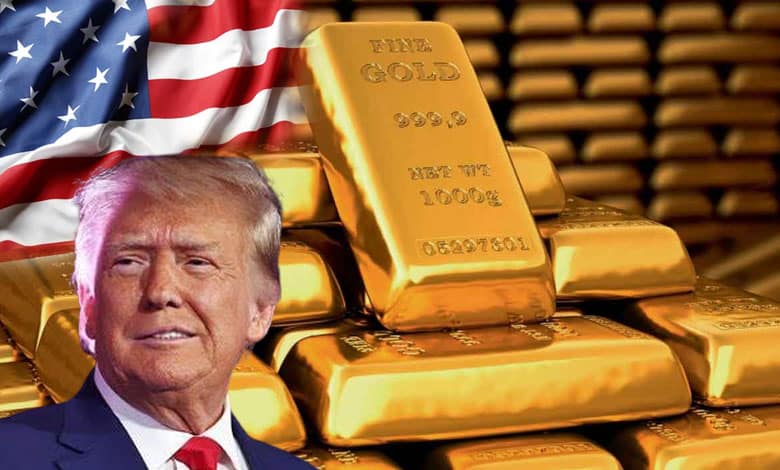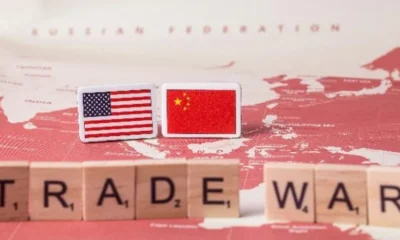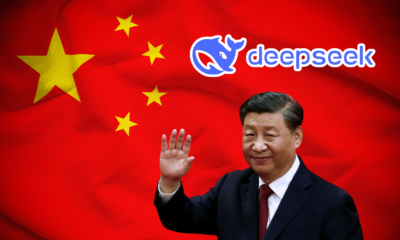Published
9 months agoon

Before U.S. President Donald Trump’s tariffs on Canada and Mexico fully kicked in, gold traders were already on high alert. The U.S. demand for gold was so strong that it started pulling bullion from other countries as investors scrambled to stock up.
Since December last year, over 600 tons (nearly 20 million ounces) of gold have been moved into New York’s vaults, according to the World Gold Council. That’s not typical, says John Reade, the Council’s market strategist for Asia and Europe. Normally, this gold would be stored in places like London, Switzerland, or Canada, but with looming tariffs, the U.S. suddenly became the preferred location.
The Tariff Factor
Trump’s decision to impose 25% tariffs on goods from Canada and Mexico had investors worried that gold imports would get hit next. The fear was that the U.S. might expand tariffs to other major gold hubs like the U.K. and Switzerland, leading traders to rush their gold into New York’s Commodities Exchange Centre before any restrictions came into play.
Canada and Mexico are two of the biggest gold exporters to the U.S., followed by Switzerland, Colombia, and South Africa, according to data from OEC World.
The Price Gap & Arbitrage Play
Since Trump’s election, U.S. gold futures have outpaced international prices, creating arbitrage opportunities. Traders with access to large quantities of bullion saw a chance to move gold into the U.S. and cash in on the premium.
For example, as of last Thursday:
—Comex gold futures were trading at $2,930.6 per ounce
—London spot gold was priced at $2,901 per ounce
That’s nearly a $30 price gap, with even wider spreads seen in January.
U.S. Vaults Overflowing
With so much gold being stockpiled, U.S. vaults now hold about four years’ worth of consumer demand, according to BullionVault. Domestic production, however, is slowing—only 160 tons of gold were produced in 2024, down from 170 tons in 2023 (U.S. Geological Survey).
Some traders believe Trump could slap a 100% tariff on gold imports overnight without significantly affecting U.S. prices because there’s already enough gold sitting in vaults.
Why Investors Are Worried
Even though physical deliveries of gold aren’t common, traders always want the option to make them. If tariffs make gold imports expensive, those holding gold in London or Zurich could find themselves at a disadvantage.
According to John Reade from the World Gold Council, “If you’re worried about tariffs, you don’t want your gold sitting in London. You need it in New York before the tariff hits.”

How U.S. Tariff Fears Are Disrupting Supply Chains
The U.S. gold buying spree is sucking it out of global supply chains at an unprecedented rate, all in anticipation of potential tariffs as a result supply chains have been disrupted because of this massive rush to bring gold into the U.S. before tariffs hit.
A big complication is Comex depositories in New York primarily deal in kilogram bars, which aren’t widely available everywhere. These bars are mostly produced in China, Southeast Asia, the Middle East, and India—which means demand has skyrocketed, putting pressure on global refineries.
There’s only so much capacity to produce these kilo bars. Now, everyone is scrambling to get their hands on them and ship them to Comex warehouses in New York. That’s disrupting other gold flows.
London Feels the Pinch
London, often seen as the world’s terminal gold market, is bearing the brunt of this shift. As inventories move from private London vaults to Comex vaults, the availability of gold in London has been shrinking.
A major issue is that London primarily stores 400-ounce gold bars, not kilo bars. That means many of these large bars are being shipped to refineries worldwide, where they’re melted down and recast into kilo bars for U.S. storage.
Gold reserves in London’s vaults dropped for the third straight month in January, down 1.7% from December (London Bullion Market Association).
—Swiss gold exports to the U.S. hit a 13-year high in January
—Singapore has also shipped more gold to the U.S. than usual.
All this movement is draining global gold supplies, leaving less available for other markets.
China’s Gold Buying Spree
Equally strong on gold buying momentum is China, more than stacking reserves—it’s a strategic move to reduce its reliance on the U.S. dollar.
This aligns with a broader trend among BRICS nations (Brazil, Russia, India, China, and South Africa), who are actively looking for ways to minimize their exposure to the dollar in global trade and finance.
The reason is the U.S. has long used the dollar’s dominance as a geopolitical tool, imposing sanctions on nations like Russia and Iran. By accumulating gold—a tangible asset with intrinsic value—China is insulating its financial system from these risks. Unlike fiat currencies, gold isn’t subject to political or economic manipulation in the same way.
A Global Trend
China isn’t the only country taking this approach. Many central banks worldwide are increasing their gold reserves, signaling a shift away from the dollar as the world’s primary reserve currency.
According to the World Gold Council (WGC), this trend is gaining momentum, with countries re-evaluating their reserve strategies.
Russia is expected to resume purchasing gold and foreign currencies soon, though the specifics remain unclear. But the intent is obvious—further diversification away from the dollar.
China’s Influence on the Gold Market
With China leading the charge, gold prices have been reacting accordingly.
Central bank demand has strengthened gold’s resilience, even as the U.S. dollar index hovers near a six-month high and U.S. 10-year bond yields hit 16-year highs above 4.35%.
Gold usually thrives when economic growth slows and bond yields drop, meaning its long-term trajectory is tied to global financial conditions.



Taiwan’s ‘Historic’ TSMC Deal, A Win Or The End Of Its ‘Silicon Shield’ As China Threatens? A Jittery Taiwan Watches Trump’s Moves On Ukraine, Wondering, Could We Be Next?


A Trade War That Just Won’t Quit. As Trump’s Tariffs Hit, China Stays The Course, For Xi’s Its Business As Usual Strategy


Indian Stock Market In Turmoil. Investors In Panic Mode, Is This A Temporary Correction Or The Start Of A Bear Market?


Shakeup In The Auto Sector. Mercedes-Benz 15% Job Cuts, Nissan CEO Exit, And Germany’s Make-Or-Break Year


DeepSeek Ai Rush. China’s AI Contender Gears Up for Next Big Launch Even As It Gets Xi Jinping’s Blessings


Trump’s Latest Tariff Move on Mexico and Canada. Import Taxes Back on Track Hinting At A Full Blown Trade War!